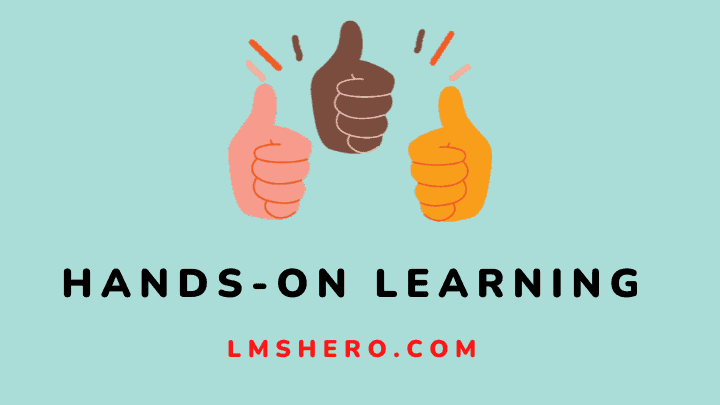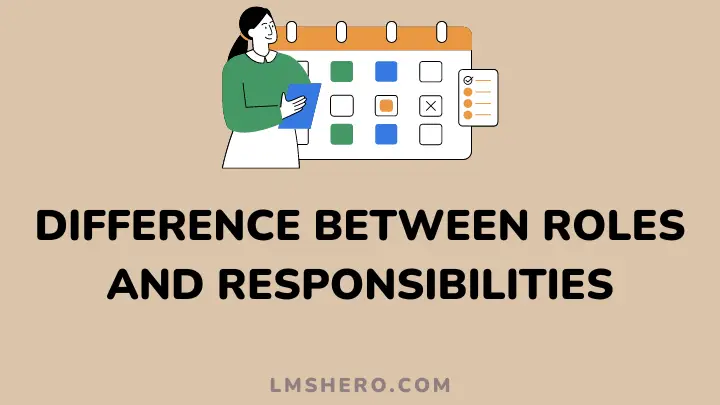No matter how basic or advanced the training is, hands-on learning is among the most effective forms of instruction.
Learning by doing, trying new technologies and software, or simply performing exercises and tasks can provide hands-on experience and skills.
Do you want to teach creatively? Then why not incorporate hands-on learning into your lessons? Students can learn by doing and then apply their knowledge.
For teachers, as well as students, to be able to use this method effectively, they must understand how it works and the benefits it provides.
In this article, you will learn how this learning process works. You will also find some advice on implementing hands-on classroom techniques and practical ideas to help you teach better.
What is hands-on learning?
Hands-on learning, or experiential learning, involves learners in an activity that stimulates their senses. It is a way to implement knowledge, learning, and/or skills.
It is an approach where the students are made to do guided experiments with practical applications.
This involves the students in simulated real-life scenarios through presentations, interactions, and experiential exercises that make the learning experience more interesting and fun.
It’s recommended for various purposes, including teaching people new (or old) skills or helping them remember and use information effectively.
How does hands-on learning work?
As the name hands-on learning suggests, the learner is doing specific tasks to understand better what he/she is being taught.
To begin with, a learning activity is designed for learners. Within this activity, the learner can make choices and use their sense of observation and experience to reach an outcome.
The hands-on approach allows students to engage and interact with their environment while gaining skills and knowledge.
Learning new skills requires both a hands-on approach and more traditional training methods, like lecturing on the content or giving an overview of what you do.
This ensures that learners get the fundamentals of what they need to know while applying it themselves through the hands-on method.
What are the benefits of hands-on learning?
1. Improve intellectual skills
Hands-on learning is one of the best approaches to improving intellectual skills. It allows learners to experiment through trial and error.
In turn, it increases their intellectual complexity and ability to use critical thinking.
Experts have shown that adults can also improve their intellectual and managerial capabilities by participating in hands-on projects.
2. Motivate students to participate in class actively
Students are more engaged in class when they learn hands-on. A lecture format limits students to passively listening to the instructor’s talk.
They aren’t allowed to participate in the learning process and aren’t made to think about how to apply what they have learned in their daily lives.
When you give your students opportunities to interact with real-world materials in class, you allow them to feel their education is making a difference.
Students who feel their education is valuable, relevant, and applicable to everyday life are more likely to stick around for future classes and other opportunities.
3. It allows for better retention of facts and information
This approach to learning encourages learners to develop their knowledge, skills, and abilities, especially when they have to apply concepts from the classroom.
Much research shows that hands-on activities with immediate feedback are practical for many learners.
Doing projects and assignments hands-on also allows for better retention of facts and information.
4. It captures the interests of all learning styles of students
Hands-on learning can be a very effective method. It captures the interest of all learning styles of students.
Whether students learn best visually, auditory, or kinesthetically, hands-on learning offers a unique opportunity for each student to get involved in their education.
They can become more engaged with the material differently, which helps the material stay with them longer.
Students who learn by doing can also transfer their knowledge better because they can apply it.
5. The opportunity for self-reflection, life experiences, and application of knowledge
The benefits of hands-on learning are many. For one, it provides a real-world environment where learners can apply knowledge and theory to the real world.
As such, practitioners can self-reflect on their work and experiences and better understand the concepts learned in an academic environment.
What are the learning styles involved in hands-on learning?
Visual learning
Hands-on learning provides an opportunity for visual learning. Visual learning is where you can visualize and make connections in your mind.
Seeing how things connect is essential for hands-on learning, as it helps you make connections in your mind. About 65% of people are visual learners.
This learning style does well with seeing what will be remembered for later recall, especially when it involves illustrations, symbols, and written representations.
Visual learners benefit from using mind maps in their organizing strategy; mind maps are colorful and include words, pictures, graphics, and other media.
Audio learning
Some people prefer this type of learning because listening still requires an attention span.
The listener must concentrate on what he/she is hearing and be actively involved in listening to get the whole meaning of the words being said.
In addition to giving students freedom, this method allows them to listen when they want to grasp what is being taught entirely.
Kinesthetic learning
Kinesthetic learning refers to the various ways learners can use their senses of touch and motion to learn.
It involves activities such as doing a particular task or movement to learn about a specific subject.
In this type of hands-on learning, the learner uses his/her body and mind to engage with the educational content and absorb the knowledge.
Through this, they learn concepts and ideas that they can later recall.
In what ways can hands-on learning benefit a career?
Hands-on learning can benefit a career in so many different ways. Some of them include the following;
- Flexibility and adaptability are increased
- You can gain valuable work experience
- Marketable skills
- Leverage innate learning skills and processes
- Observation skills improve, as does critical thinking
- It demonstrates under which conditions specific techniques or methods are best applied
- Boosts portfolio
- More confidence to take the lead
Because hands-on learning combines all cognitive processes, it can benefit a career in many ways.
Hands-on learning can improve a student’s ability to retain information and solve problems because he or she is more engaged in the class and interested in what is being taught.
In addition, hands-on learning allows the student to use basic strategies that he/she will encounter later in his career and solve problems using the same approach he or she learned in class.
Students studying oceanography learn how to measure salinity and pH levels correctly while understanding the reasoning behind the measurements.
This knowledge transfer allows students to successfully assess similar problems they may encounter as part of their chosen career field.
Tips for implementing hands-on learning in schools
Implementing hands-on learning in your school can be a challenge.
If you’re unsure where to start, look at this list of ideas that are easy to execute and help promote student learning and retention simultaneously.
1. Create a focus
Creating a focus is one way to ensure you use hands-on learning in your classroom.
A focus is a single area of inquiry, process, or concept that guides all of the activities in your classroom.
If you believe in learning by doing, a focus will also guide everything you do, from planning lessons and activities to assessing student progress.
By doing this, you’ll be able to avoid handing out worksheets to students or creating lesson plans that are poorly designed.
2. Do it with real-world objects and incorporate high-interest activities
Hands-on learning is the use of objects and experience to learn. This can be achieved by using real-world objects or simulations of objects before applying knowledge.
For teachers, hands-on experiences help them make lessons more memorable for their students.
Students are also motivated to learn, especially when it involves a high level of interest.
3. Provide time and space for the learning process
You may have the perfect idea for a hands-on activity. But even the best lesson has its limits. A good start is on the first day of school (or before).
It would be preferable if you began by introducing yourself to the class and then took a few minutes to get to know each other.
Other tasks at this time include outlining anything you need to change that wasn’t in place last semester, such as classroom rules or procedures.
By providing a sense of scheduling and safety, you’ll set up the class to be prepared so they can focus on the learning process.
4. Aim for a balance of active, hands-on learning and collaborative group work
As more teachers embrace hands-on learning, they realize the importance of creating a balance between active, hands-on learning and collaborative group work.
Group work lets students who might normally be left behind interact with other excelling students.
Besides, many studies show that a mix of active, hands-on learning plus group exercises and collaborative group work produces the best results.
Students like the freedom to approach a subject from an angle that interests them, but they also benefit from working together in a collaborative setting.
5. Evaluate the results
After the students have completed an activity that includes hands-on learning, the teachers and instructors should evaluate what took place during the activity.
Did the students learn anything from the activity? How well did they retain their new knowledge henceforth?
What new skills did they develop as a result of the hands-on experience? The most important element of authentic learning is the evaluation process.
You always need to know what your students are doing, how well they understand specific topics, and what type of feedback you’re providing them that will help them through their learning process.
What are some ways parents can prepare their kids for hands-on learning?
Hands-on learning is a great way to teach your child the importance of critical thinking skills, problem-solving and accepting consequences for their mistakes.
Some ways you can prepare your child for hands-on learning include:
- Discovering their interests
- Organizing simple DIY tasks in the house
- Playing games that teach kids to use critical thinking
- Reading stories about people who have accomplished a lot. This will motivate and inspire them.
- Providing hands-on activities at home, like baking, gardening, or art projects
- Finding a good preschool program that focuses on hands-on learning
Several ways exist for parents to prepare their kids for the experiences they will have in school and beyond.
In the end, getting your kids to learn hands-on from their own experiences makes life easier for them as they move forward.
Teach your children that the things they love affect their actions and lives.
FAQs
Is hands-on learning for everyone?
Hands-on learning isn’t for everyone; not every type of lesson lends itself to this type of learning. Hands-on learning is great for a single student or small group.
When is the right time to use hands-on learning?
Hands-on learning can be best used in almost every subject, especially for science and technology-related topics.
This is because most scientific concepts are well explained when the experiment or activity is being demonstrated.
How can students make money from the hands-on learning experiences they have in college?
Students can make money from hands-on experience from different sources. For example, students can sell their skills as troubleshooters to repair equipment in an office or kitchen. They can also sell art and stuff. Your options are limitless.
Final thoughts
Hands-on learning is simply instruction that requires active participation. This can be either physical or verbal interaction from a classroom teacher.
Experts and business organizations in e-learning prefer hands-on learning environments because they have so much to offer.
Hands-on instruction and activities allow students to transfer what they have learned from the classroom into an actual situation.
You can also read more about learning through play. It is one of the most effective ways children learn new things.
Thanks for reading.







